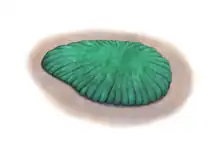| Persimedusites chahgazensis | |
|---|---|
 | |
| Artist's restoration | |
| Scientific classification | |
| Kingdom: | |
| Phylum: | |
| Class: | Cyclozoa |
| Genus: | †Persimedusites Hahn et Pflug, 1980 |
| Species: | †P. chahgazensis |
| Binomial name | |
| †Persimedusites chahgazensis Hahn et Pflug, 1980 | |
Persimedusites chahgazensis is a Precambrian discoidal species which are believed to have existed primarily during the late Ediacaran period.[1] It was discovered initially in the Kushk Series in the Bafq and Behabad regions of central Iran, along with similarly aged specimen of Cloudina and Corumbella.[2][3] The body fossils of these disc-shaped organisms are approximately one centimeter in diameter, and were noted to have symmetrical internal lobes, as well as secondary distal branches.[4]
These preserved branching structures have a noted resemblance to tentacles, and have been observed to be similar to the oral view of Eolympia pediculata.[5] Similar fossils from the late Neoproterozoic Cerro Negro Formation in Argentina have been suggested to resemble Aspidella, but the Iranian specimens lack the customary holdfasts. An important feature of Perimedusites lacked by many similarly disc-shaped late Ediacaran fossils is the radial branches that extend from their center, creating a repetitive structure. Rugoconites enigmaticus, however, does manifest a similar structure, making it possibly comparable[4]
As a member of the phylum Cnidaria, Persimedusites has been hypothesized to resemble a modern jellyfish due to their four-fold radial symmetry.,[6] but the true form of these fossils cannot yet be interpreted unequivocally[4]
See also
References
- ↑ "Figure 2. Ediacaran fossils from the Kushk Series, Kushk and Chahmir..." ResearchGate. Retrieved 2020-01-01.
- ↑ Vaziri, Seyed Hamid; Laflamme, Marc (2018-08-08). "Lithostratigraphy and sedimentary environment of the Precambrian Kushk Series of central Iran". Canadian Journal of Earth Sciences. 55 (11): 1284–1296. Bibcode:2018CaJES..55.1284V. doi:10.1139/cjes-2017-0234. hdl:1807/90152. ISSN 0008-4077.
- ↑ Vaziri, Seyed Hamid; Majidifard, Mahmoud Reza; Laflamme, Marc (2018-03-22). "Diverse Assemblage of Ediacaran fossils from Central Iran". Scientific Reports. 8 (1): 5060. Bibcode:2018NatSR...8.5060V. doi:10.1038/s41598-018-23442-y. ISSN 2045-2322. PMC 5864923. PMID 29567986.
- 1 2 3 Vickers-Rich, Patricia; Soleimani, Sara; Farjandi, Farnoosh; Zand, Mehdi; Linnemann, Ulf; Hofmann, Mandy; Wilson, Siobhan A.; Cas, Raymond; Rich, Thomas H. (2018-04-03). "A preliminary report on new Ediacaran fossils from Iran". Alcheringa: An Australasian Journal of Palaeontology. 42 (2): 230–243. doi:10.1080/03115518.2017.1384061. ISSN 0311-5518. S2CID 135162662.
- ↑ Han, Jian; Kubota, Shin; Uchida, Hiro-omi; Jr, George D. Stanley; Yao, Xiaoyong; Shu, Degan; Li, Yong; Yasui, Kinya (2010-10-13). "Tiny Sea Anemone from the Lower Cambrian of China". PLOS ONE. 5 (10): e13276. Bibcode:2010PLoSO...513276H. doi:10.1371/journal.pone.0013276. ISSN 1932-6203. PMC 2954142. PMID 20967244.
- ↑ De, Chirananda (2006-09-15). "Ediacara fossil assemblage in the upper Vindhyans of Central India and its significance". Journal of Asian Earth Sciences. 27 (5): 660–683. Bibcode:2006JAESc..27..660D. doi:10.1016/j.jseaes.2005.06.006. ISSN 1367-9120.